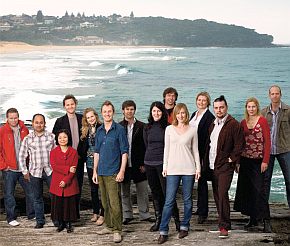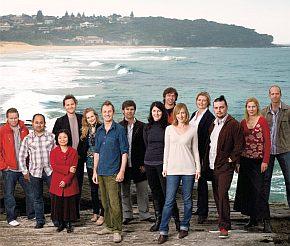
Tognetti and his 21-piece group can apparently play anything, and they play it all with tremendous verve. Presented by Cal Performances, Sunday’s varied program included music by Franz Joseph Haydn, George Frideric Handel, Pavel Haas, Roger Smalley, and, in the encore, Jean-Philippe Rameau. In each work, the orchestra was dynamic; with Tognetti as leader and frequent soloist, the string sound is crisp and vivacious, the ensemble playing unified and articulate. This is one chamber group whose members all seem utterly tuned in: to their leader, to each other, and to the music at hand.
Still, the program’s high point came with the addition of its soloist, countertenor Andreas Scholl. In six arias by Handel, the pairing of the German singer and the Australian players produced a synchronicity that turned a fine performance into a brilliant one.
Scholl, who is on a very short list of the world’s top countertenors, possesses a voice of almost unearthly purity of tone, an elegant line, and unerring musical intelligence. Sunday, he melded seamlessly with Tognetti and the orchestra, both sartorially (everyone in the ASO dresses in coffeehouse chic, and the tall, lanky Scholl entered looking casual, in black shirt and slacks) and in his intensely vibrant, pointedly dramatic readings of selections from Handel’s Giulio Cesare, Giustino, Rodelinda, and Saul.
Stopping Time

Scholl’s command of ornamentation is an awesome thing. In “Se parla nel mio cor” (If audacious courage speaks to me through my heart), from Giustino, and “Va tacito e nascosto” (Silently and stealthily moves the crafty hunter), from Giulio Cesare — the latter featuring a handsome horn obbligato played by Robert Johnson — the technique was sure, the voice generous. “Aure, deh, per pietà” (Breezes, for pity’s sake), also from the latter opera, emerged as a gripping minidrama, with Scholl dispatching the aria’s long-breathed lines with astonishing ease.
Best of all was “O Lord, Whose Mercies Numberless” from Handel’s oratorio Saul — an ethereal performance of breathtaking purity and pathos. Scholl’s voice has changed since his first Bay Area appearance with Philharmonia Baroque Orchestra a few years back; it’s richer now, more fully human. Here, though, he produced that gorgeously austere, nearly instrumental vocal quality that distinguished some of his early recordings. Tognetti and the orchestra lent him buoyant support.
(When, by the way, will the San Francisco Opera bring Scholl to the War Memorial Opera House? His local opera debut is long overdue.)
New/Old Czech Work
Scholl’s appearance was dazzling. But it was by no means the only musical attraction. The ACO played four movements from Haas’ Monkey Mountains Suite (1925), arranged by Tognetti for string orchestra from the Czech composer’s Quartet No. 2, Op. 7. This is a thorny piece that straddles 19th-century Romanticism and 20th-century modernism; led by Tognetti, it sounded cohesive and vibrant, with the finale, titled “A Wild Night,” receiving a particularly jazzy performance (including the oft-omitted percussion part, played by cellist Julian Thompson). Strong solos were contributed by Tognetti, violist Christopher Moore, and cellist Timo-Veikko Valve.The orchestra also gave the U.S. premiere of Smalley’s Footwork for string orchestra, an engaging, 10-minute score in three sections, the second of which is a dark-hued milonga. Tognetti led the strings in a tightly calibrated performance.
The program opened with Haydn’s Symphony No. 44 in E Minor, “Mourning” (so named because the composer is said to have asked that its third movement be played at his funeral). That movement, with its sudden infusion of woodwinds, came across with admirable delicacy. But the rest of the symphony sounded muscular, forceful.
So, too, did the encore, war music from the final movement of Rameau’s “Dardanus” Suite. Some orchestras tame this music’s martial bombast; Tognetti and his band delivered it unabashedly, with great pitch and moment.

